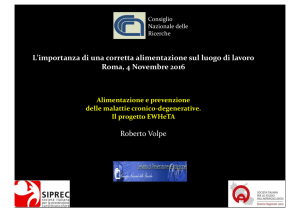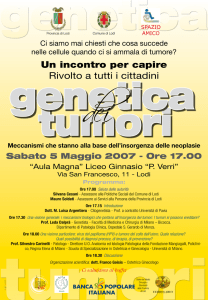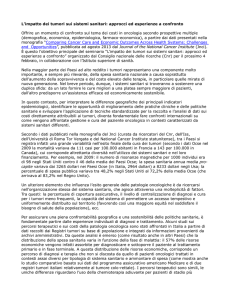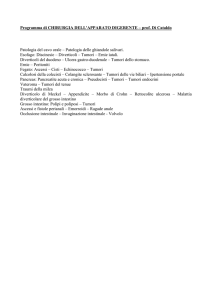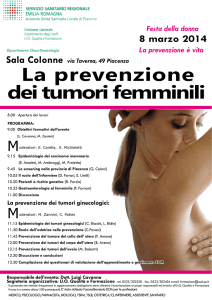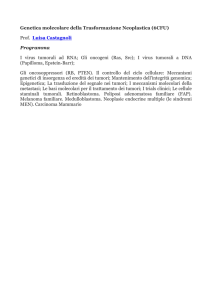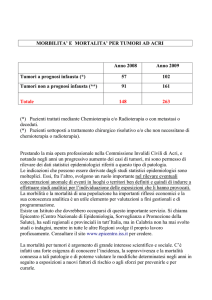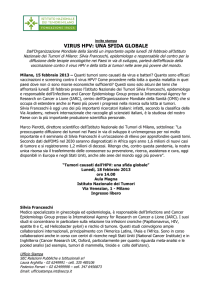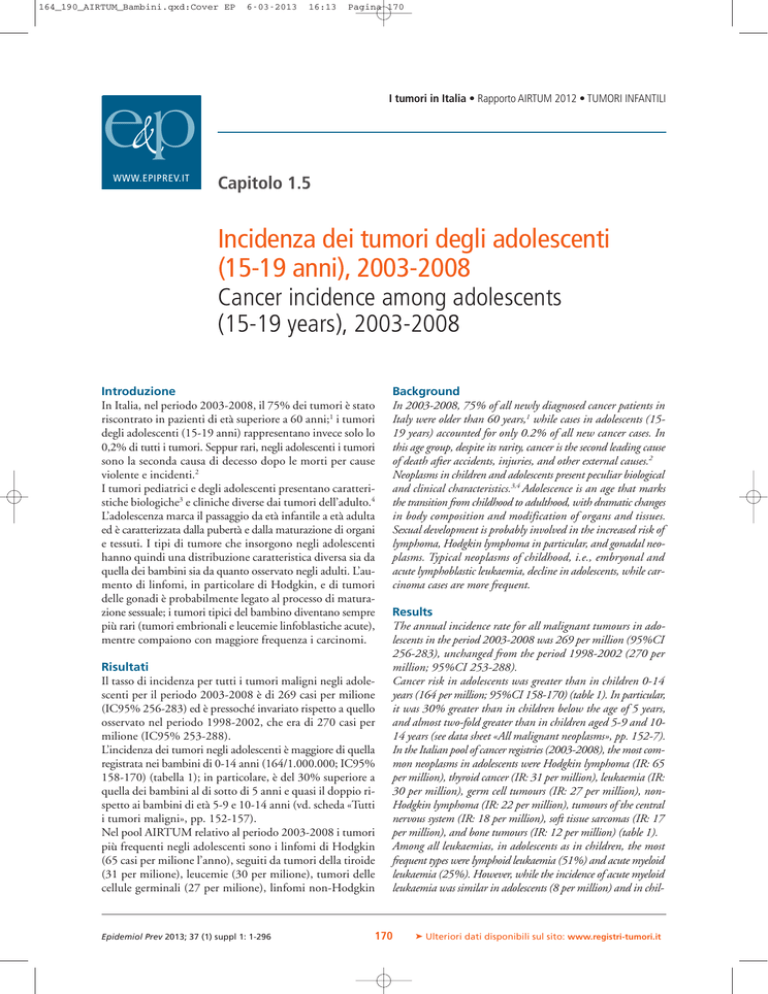
164_190_AIRTUM_Bambini.qxd:Cover EP
6-03-2013
16:13
Pagina 170
I tumori in Italia • Rapporto AIRTUM 2012 • TUMORI INFANTILI
WWW.EPIPREV.IT
Capitolo 1.5
Incidenza dei tumori degli adolescenti
(15-19 anni), 2003-2008
Cancer incidence among adolescents
(15-19 years), 2003-2008
Introduzione
In Italia, nel periodo 2003-2008, il 75% dei tumori è stato
riscontrato in pazienti di età superiore a 60 anni;1 i tumori
degli adolescenti (15-19 anni) rappresentano invece solo lo
0,2% di tutti i tumori. Seppur rari, negli adolescenti i tumori
sono la seconda causa di decesso dopo le morti per cause
violente e incidenti.2
I tumori pediatrici e degli adolescenti presentano caratteristiche biologiche3 e cliniche diverse dai tumori dell’adulto.4
L’adolescenza marca il passaggio da età infantile a età adulta
ed è caratterizzata dalla pubertà e dalla maturazione di organi
e tessuti. I tipi di tumore che insorgono negli adolescenti
hanno quindi una distribuzione caratteristica diversa sia da
quella dei bambini sia da quanto osservato negli adulti. L’aumento di linfomi, in particolare di Hodgkin, e di tumori
delle gonadi è probabilmente legato al processo di maturazione sessuale; i tumori tipici del bambino diventano sempre
più rari (tumori embrionali e leucemie linfoblastiche acute),
mentre compaiono con maggiore frequenza i carcinomi.
Risultati
Il tasso di incidenza per tutti i tumori maligni negli adolescenti per il periodo 2003-2008 è di 269 casi per milione
(IC95% 256-283) ed è pressoché invariato rispetto a quello
osservato nel periodo 1998-2002, che era di 270 casi per
milione (IC95% 253-288).
L’incidenza dei tumori negli adolescenti è maggiore di quella
registrata nei bambini di 0-14 anni (164/1.000.000; IC95%
158-170) (tabella 1); in particolare, è del 30% superiore a
quella dei bambini al di sotto di 5 anni e quasi il doppio rispetto ai bambini di età 5-9 e 10-14 anni (vd. scheda «Tutti
i tumori maligni», pp. 152-157).
Nel pool AIRTUM relativo al periodo 2003-2008 i tumori
più frequenti negli adolescenti sono i linfomi di Hodgkin
(65 casi per milione l’anno), seguiti da tumori della tiroide
(31 per milione), leucemie (30 per milione), tumori delle
cellule germinali (27 per milione), linfomi non-Hodgkin
Epidemiol Prev 2013; 37 (1) suppl 1: 1-296
Background
In 2003-2008, 75% of all newly diagnosed cancer patients in
Italy were older than 60 years,1 while cases in adolescents (1519 years) accounted for only 0.2% of all new cancer cases. In
this age group, despite its rarity, cancer is the second leading cause
of death after accidents, injuries, and other external causes.2
Neoplasms in children and adolescents present peculiar biological
and clinical characteristics.3,4 Adolescence is an age that marks
the transition from childhood to adulthood, with dramatic changes
in body composition and modification of organs and tissues.
Sexual development is probably involved in the increased risk of
lymphoma, Hodgkin lymphoma in particular, and gonadal neoplasms. Typical neoplasms of childhood, i.e., embryonal and
acute lymphoblastic leukaemia, decline in adolescents, while carcinoma cases are more frequent.
Results
The annual incidence rate for all malignant tumours in adolescents in the period 2003-2008 was 269 per million (95%CI
256-283), unchanged from the period 1998-2002 (270 per
million; 95%CI 253-288).
Cancer risk in adolescents was greater than in children 0-14
years (164 per million; 95%CI 158-170) (table 1). In particular,
it was 30% greater than in children below the age of 5 years,
and almost two-fold greater than in children aged 5-9 and 1014 years (see data sheet «All malignant neoplasms», pp. 152-7).
In the Italian pool of cancer registries (2003-2008), the most common neoplasms in adolescents were Hodgkin lymphoma (IR: 65
per million), thyroid cancer (IR: 31 per million), leukaemia (IR:
30 per million), germ cell tumours (IR: 27 per million), nonHodgkin lymphoma (IR: 22 per million), tumours of the central
nervous system (IR: 18 per million), soft tissue sarcomas (IR: 17
per million), and bone tumours (IR: 12 per million) (table 1).
Among all leukaemias, in adolescents as in children, the most
frequent types were lymphoid leukaemia (51%) and acute myeloid
leukaemia (25%). However, while the incidence of acute myeloid
leukaemia was similar in adolescents (8 per million) and in chil-
170
® Ulteriori dati disponibili sul sito: www.registri-tumori.it
164_190_AIRTUM_Bambini.qxd:Cover EP
6-03-2013
16:13
Pagina 171
Incidenza dei tumori degli adolescenti (15-19 anni))
I tumori in Italia • Rapporto AIRTUM 2012 • TUMORI INFANTILI
(22 per milione), tumori del sistema nervoso centrale (18
per milione), sarcomi delle parti molli (17 per milione) e
tumori dell’osso (12 per milione) (tabella 1).
Come per i bambini, anche per gli adolescenti, le leucemie
più frequenti sono quelle linfoidi (51%), seguite dalle leucemie
mieloidi acute (25%). Tuttavia, mentre l’incidenza di leucemia
mieloide acuta è simile tra adolescenti (8 per milione) e bambini
(7 per milione), quella di leucemia linfoblastica negli adolescenti
(15 per milione) è circa un terzo rispetto a quanto osservato
nei bambini (44 per milione) (tabella 1).
L’incidenza dei tumori maligni del sistema nervoso centrale
(SNC) è di 18 per milione, ma sale a 29 per milione includendo anche i tumori non maligni. L’incidenza negli adolescenti è lievemente inferiore a quella osservata nei bambini,
e include principalmente astrocitomi (36% del totale), tumori
di tipo embrionale del sistema nervoso centrale (21%) seguiti
con frequenza simile a ependimomi (14%) e altri gliomi maligni (13%) (vd. scheda «CNS maligni», pp. 68-73).
Tra tutti i tumori dell’osso, i più frequenti sono l’osteosarcoma (50%) e i tumori di Ewing (28%). Negli adolescenti,
i tumori a cellule germinali si localizzano principalmente a
livello delle gonadi (81%). Negli adolescenti, i tumori embrionali (SNC escluso) quali neuroblastoma, nefroblastoma
AGE (YEARS)
All malignant tumours
I Leukaemia
Ia Lymphoid leukaemia
Ib Acute myeloid leukaemia
0-14
0-19
IR
(95%CI)
164 (158-170)
54 (51-58)
44 (40-47)
7
(6-8)
IR
269
30
15
8
II Lymphoma
IIa Hodgkin lymphoma
IIb-c Non-Hodgkin lymphoma
25
11
11
(23-28)
(9-12)
(10-13)
90
65
22
III CNS tumours
21
(19-23)
18
VI Renal tumour
9
(7-10)
1
VII Hepatic tumour
2
(1-3)
1
VIII Malignant bone tumour
8
(7-10)
12
11
(9-12)
17
5
(4-6)
27
3
(2-4)
31
IX Soft tissue
and other extraosseous sarcomas
X Germ cell tumour, trophoblastic
tumour, and neoplasms of the gonads
XIb Thyroid carcinoma
Tabella 1. Tassi di incidenza annuali (IR) per milione e intervalli di confidenza al 95%
(IC95%) per tumori maligni diagnosticati nei bambini (0-14 anni) e negli adolescenti
(15-19 anni) nella banca dati AIRTUM nel periodo 2003-2008.
Table 1. Annual incidence rates (IR) per million and 95% confidence intervals (95%CI)
of malignant neoplasms diagnosed in children (0-14 years) and adolescents (15-19
years) by tumour type; period 2003-2008.
IIa Hodgkin lymphoma
24%
XIb Thyroid carcinoma
11%
I Leukaemia
11%
X Germ cell tumour, trophoblastc tumour, and neoplasms of the gonads
10%
IIb-IIc Non-Hodgkin lymphoma
8%
XId Melanoma
7%
III Malignant tumours of the central nervous system
7%
IX Soft tissue and other extraosseous sarcomas
6%
VIII Bone tumour
5%
VI Renal tumour
0%
VII Hepatic tumour
0%
IV Neuroblastoma and other peripheral nervous cell tumours
BOYS
80
0%
GIRLS
60
40
20
0
20
INCIDENCE RATES X 1,000,000
Epidemiol Prev 2013; 37 (1) suppl 1: 1-296
171
40
60
80
Figura 1. Tassi annuali di incidenza per milione e frequenze relative (sul totale
esclusi non maligni del sistema
nervoso centrale), per le principali categorie di tumori maligni diagnosticati negli adolescenti (15-19 anni) nella
banca dati AIRTUM nel periodo 2003-2008, per genere.
Figure 1. Incidence rates
(million/year) and relative frequency of major types of malignant neoplasms in adolescents (15-19 years) by gender, period 2003-2008.
® Ulteriori dati disponibili sul sito: www.registri-tumori.it
164_190_AIRTUM_Bambini.qxd:Cover EP
6-03-2013
16:13
Pagina 172
I tumori in Italia • Rapporto AIRTUM 2012 • TUMORI INFANTILI
Incidenza dei tumori degli adolescenti (15-19 anni))
ed epatoblastoma sono rarissimi (<1 per milione l’anno);
nella banca dati AIRTUM non è stato osservato alcun caso
di retinoblastoma negli adolescenti. E' importante sottolineare che i tumori del rene e del fegato negli adolescenti
sono rappresentati per la maggior parte (>70%) da carcinomi
invece che da tumori embrionali, nefroblastoma e da epatoblastoma tipici dei bambini.
Infine, negli adolescenti cominciano a comparire alcuni tumori (epiteliali e non epiteliali) tipici dell’età adulta. Tra i
tumori epiteliali (ICCC gruppo XI), i più frequenti sono i
carcinomi della tiroide (46%), i melanomi (27%), i carcinomi della pelle (8%) e quelli del nasofaringe (5%).
Nella figura 1 sono riportati i tassi di incidenza per genere
e tipo di tumore. I tassi di incidenza annui per il complesso
dei tumori maligni non sono significativamente diversi nei
ragazzi (274 per milione; IC95% 256-294) rispetto alle ragazze (264 per milione; IC95% 246-283). Il rapporto M/F
più elevato si osserva per i tumori dell’osso (3,7), seguiti da
tumori delle cellule germinali (2,6) e sarcomi dei tessuti
molli (1,6). Il tasso di incidenza del complesso dei linfomi
(la neoplasia più frequente negli adolescenti) è uguale in
maschi e femmine: 91 per milione e 90 per milione, rispettivamente. I linfomi di Hodgkin appaiono più frequenti
nelle ragazze (71 per milione; IC95% 62-82), rispetto ai ragazzi (58 per milione; IC95%: 50-67). Viceversa il tasso di
incidenza è più alto nei maschi per i linfomi non-Hodgkin,
incluso il linfoma di Burkitt, (27 per milione; IC95% 2133) rispetto alle femmine (17 per milione; IC95% 12-22)
e per le leucemie linfoidi (maschi: 19 per milione; IC95%
15-25; femmine: 11 per milione; IC95% 7-15).
Il rapporto M/F è pari a 1 per i tumori del sistema nervoso
centrale anche includendo i non maligni, mentre il complesso
di altri tumori epiteliali e melanoma è significativamente
più frequente nelle ragazze nel periodo 2003-2008 (femmine:
89 per milione; IC95% 79-101 vs. maschi: 46 per milione;
IC95% 39-55) con un rapporto M/F di 0,5. L’incidenza di
questi tumori fra le ragazze è oggi pari al tasso di incidenza
dei linfomi (90 per milione). La figura 1 mostra che l’eccesso
nelle ragazze è a carico soprattutto dei tumori della tiroide
(3 volte più frequente che nei ragazzi) e dei melanomi (1
volta e mezzo più elevato che nei ragazzi), analogamente a
quello che si rileva negli adulti. Il maggior rischio delle
ragazze in relazione a questi tumori era già stato osservato
nella precedente monografia, come anche in altri Paesi europei;5 la differenza fra sessi é aumenta negli anni più recenti
(vd. «Trend di incidenza», pp. 175-184).
In tabella 2 sono riportati i tassi di incidenza suddivisi per
aree geografiche di residenza in Italia. Le distribuzioni relative
per tipo di tumore sono molto simili nelle quattro macroaree
e riflettono tassi di incidenza specifici medi non significativamente diversi per tutti i tipi di neoplasia.
Paragoni geografici internazionali sono possibili con i Paesi
scandinavi6 (Danimarca, Finlandia, Isole Faroe, Islanda,
dren (7 per million), the incidence of lymphoid leukaemia in
adolescents (15 per million) was much lower than in children
(44 per million) (table 1).
The incidence of malignant tumours of the central nervous system
was 18 per million and rose to 29 per million including nonmalignant tumours. Tumours of the central nervous system, the
incidence of which was slightly lower in adolescents than in children, were mainly astrocytomas (36% of all malignant CNS),
intracranial and intraspinal embryonal tumours (21%), followed
by ependymomas (14%), and other gliomas (13%) (see data
sheet «malignant CNS», pp. 68-73).
Among all bone tumours, the most common in adolescents were
osteosarcoma (50%) and Ewing’s sarcoma (28%). The large majority (81%) of germ cell neoplasms were located in the gonads.
In adolescents, embryonal tumours (other than CNS) such as neuroblastoma, nephroblastoma, and hepatoblastoma were rare (<1
per million), and no cases of retinoblastoma were recorded in the
study period. It is worth noting that, in adolescents most tumours
of the kidney and liver (>70%) were carcinomas, while in children
the majority were nephroblastoma and hepatoblastoma.
Finally, some tumours (epithelial and non-epithelial) typical of
adulthood were also observed in adolescents. The most common
epithelial tumours were thyroid carcinoma (46%), melanoma
(27%), carcinoma of the skin (8%) and nasopharynx (5%).
Figure 1 shows incidence rates of cancers among adolescents by
gender. Incidence rates for all malignant tumours were slightly
higher in boys (274 per million; 95%CI 256-294) than in girls
(264 per million; 95%CI 246-283). The highest M/F ratio was
observed for bone tumours (3.7), followed by germ cell tumours
(2.6) and soft tissue sarcomas (1.6). The incidence rate of lymphomas (the most common cancer group in adolescents) was the
same in males and females: 91 and 90 per million, respectively.
However, Hodgkin lymphoma were more common in girls (71
per million; 95%CI 62-82) than in boys (58 per million; 95%CI
50-67), while non-Hodgkin lymphoma, including Burkitt's lymphoma, were more common in boys (27 per million; 95%CI
21-33) than in girls (17 per million; 95%CI 12-22). Lymphoid
leukaemia was also more common in males (19 per million;
95%CI 15-25) than in females (11 per million; 95%CI 7-15).
The M/F ratio was 1 for tumours of the central nervous system
(even when including non-malignant tumours), while epithelial
tumours were much more common in girls in the period 20032008 (89 per million; 95%CI 79-101vs 46 per million; 95%CI
39-55 in boys) with M/F =0.5. The incidence rate of these tumours
in girls is close to the rate of lymphomas (90 per million).
Figure 1 shows that the excess of epithelial tumours in girls was
mainly due to thyroid cancer (3-fold more common in girls than
in boys) and melanoma (1.5-fold higher in girls than in boys),
similarly to what is observed in adults. For these neoplasms, the
greatest risk in girls had already been observed in the previous
monograph for the years 1998-2002, as in other European Countries,5 and the gender gap has widened in recent years (see «Incidence trends», pp. 175-184).
Epidemiol Prev 2013; 37 (1) suppl 1: 1-296
172
® Ulteriori dati disponibili sul sito: www.registri-tumori.it
164_190_AIRTUM_Bambini.qxd:Cover EP
6-03-2013
16:13
Pagina 173
Incidenza dei tumori degli adolescenti (15-19 anni))
I tumori in Italia • Rapporto AIRTUM 2012 • TUMORI INFANTILI
All malignant neoplasms
Leukaemia
Lymphoid leukaemia
Acute myeloid leukaemia
Lymphomas
Hodgkin lymphoma
Non-Hodgkin lymphoma
Central nervous system neoplasms
Renal tumours
Hepatic tumours
Malignant bone tumours
Soft tissue sarcomas
Germ cell neoplasms
Carcinomas and other
malignant epithelial neoplasms
Thyroid cancers
NORTH-WEST
NORTH-EAST
CENTRE
SOUTH
IR (95%CI)
263 (240-287)
22 (16-30)
11
(7-16)
8
(5-13)
93 (79-107)
68 (56-80)
24 (17-32)
17 (11-23)
0
(0-2)
1
(0-4)
14 (10-21)
19 (13-26)
29 (22-37)
64 (53-77)
IR (95%CI)
280 (255-308)
28 (20-37)
14
(8-21)
5
(2-10)
95 (80-112)
71 (59-86)
21 (14-29)
15 (10-23)
3
(1-7)
1
(0-5)
8
(4-14)
15
(9-22)
30 (22-39)
81 (67-96)
IR (95%CI)
286 (252-324)
33 (22-48)
23 (14-36)
5
(1-12)
99 (79-122)
64 (49-84)
29 (19-42)
31 (20-45)
1
(0-6)
1
(0-6)
15
(8-26)
14
(7-24)
21 (12-33)
66 (50-58)
IR (95%CI)
258 (235-284)
38 (29-48)
18 (12-25)
11
(6-17)
80 (67-94)
55 (45-68)
18 (12-25)
15 (10-22)
2
(0-5)
1
(0-4)
12
(8-19)
18 (12-26)
24 (17-33)
58 (48-71)
30
(23-39)
33
(24-43)
31
(20-45)
31
(23-40)
Tabella 2. Tassi annuali di incidenza (IR) per milione e intervalli di confidenza al 95% (IC95%) per i principali tumori maligni diagnosticati negli
adolescenti (15-19 anni) nella banca dati AIRTUM nel periodo 2003-2008, per area geografica di residenza.
Table 2. Annual incidence rates (IR) per million and 95% confidence interval (95%CI) of malignant tumours, by type and geographic area.Adolescents
(15-19 years); period 2003-2008.
All malignant neoplasms
All lymphomas
Hodgkin lymphoma
Leukaemia#
CNS, including non malignant
Thyroid
Skin melanoma
AIRTUM POOL
(2003-2008)
USA SEER (WHITE) NORDIC COUNTRIES UNITED KINGDOM
(2000-2009)8
(2003-2008)6
(2006-2008)7
M
274
91
58
32
28
16
14
M
F
247
216
56
48
32
35
40
26
43 (25§) 32 (20§)
8
37
15
24
F
264
90
71
27
30
47
22
M
221
48
33
29
45§
4
8
F
199
50
41
18
43§
17
19
M
202
50
32
33
18§
4
10
F
167
44
33
16
15§
12
17
• Tumori maligni: ICCC=1-12, SNC (esclusi i non maligni), ICD-10:9 C00-C96
Malignant tumours: ICCC=1-12, CNS (excluding non-malignant), ICD-10:9 C00-C96
# Linfomi: ICCC=02, ICD-10:9 C82-C88, C96
Lymphomas: ICCC=02, ICD-10:9 C82-C88, C96
§ Solo tumori maligni
Malignant tumours only
Tabella 3. Tassi di incidenza per milione l’anno negli adolescenti (15-19) per sesso in Italia, USA, Paesi Scandinavi e Regno Unito.
Table 3. Incidence rates per million per year in adolescents (15-19 years) by gender – Italy, USA, Nordic Countries, and United Kingdom.
Norvegia, Svezia) per gli anni 2003-2008, con la Gran Bretagna7 per gli anni 2006-2008 e con gli Stati Uniti8 per il
periodo 2000-2009. Solo per gli Stati Uniti i tassi sono disponibili secondo la classificazione ICCC, mentre negli altri
Paesi i dati sono disponibili per tumori definiti secondo la
classificazione internazionale delle malattie ICD-10.9 Riportiamo quindi confronti solo per raggruppamenti di neoplasie congruenti nelle due classificazioni (tabella 3).
In Italia, il tasso di incidenza per tutti i tumori maligni nella
classe di età 15-19 è più elevato di circa un quarto rispetto
a quello americano (247 nei maschi e 216 nelle femmine) e
di circa un terzo rispetto ai Paesi scandinavi (221 nei maschi
e 199 nelle femmine) e al Regno Unito (202 nei maschi e
167 nelle femmine). Queste differenze erano state osservate
Epidemiol Prev 2013; 37 (1) suppl 1: 1-296
Table 2 shows incidence rates in adolescents by geographical area.
Distribution by cancer subgroup was similar in the four Italian
areas examined, reflecting incidence rates that are not statistically
different for any of the cancer groups.
At the international level, geographical comparisons can be made
with the Nordic Countries6 (Denmark, Faroe Islands, Finland,
Iceland, Norway, Sweden) for the years 2003-2008, the United
Kingdom7 for the years 2006-2008, and the United States8 for
the period 2000-2009. Unfortunately, tumour rates were available by ICCC group only for the United States, while in the
other Countries tumours were classified using the 10th Revision
of the International Classification of Diseases.9 We therefore
report comparisons for selected groups of neoplasms defined consistently in the data sources (table 3).
173
® Ulteriori dati disponibili sul sito: www.registri-tumori.it
164_190_AIRTUM_Bambini.qxd:Cover EP
6-03-2013
16:13
Pagina 174
I tumori in Italia • Rapporto AIRTUM 2012 • TUMORI INFANTILI
Incidenza dei tumori degli adolescenti (15-19 anni))
anche nella precedente monografia per gli anni 1998-2002.
La distribuzione dei gruppi diagnostici in Italia è simile a
quella degli altri Paesi considerati (tabella 3), ma è necessario
sottolineare alcune differenze. Le maggiori diversità si osservano per i linfomi, specialmente per quelli di Hodgkin,
il cui tasso in Italia è circa il doppio di quello osservato nei
giovani di Stati Uniti, Regno Unito e Paesi del Nord Europa
(tabella 3). Tassi più elevati in Italia rispetto agli altri Paesi
si osservano anche per il tumore della tiroide. I tassi di incidenza di leucemie in Italia nelle femmine sono simili a
quelli in USA e leggermente più elevati di quelli osservati
nelle giovani di Regno Unito e Paesi del Nord Europa, mentre sono molto simili nei ragazzi (tabella 3).
In Italy, incidence rates for all cancers combined in the age group
15-19 were about 25% higher than in the USA (247 per million
in boys and 216 per million in girls) and 30% higher than in
the Nordic Countries (221 per million in boys and 199 per million,in girls) and the UK (202 per million in boys and 167 per
million in girls). These differences had already been observed in
the previous monograph for the years 1998-2002.
The distribution of diagnostic groups in Italy was similar to that
of the other Countries considered (table 3), but a number of differences emerged. The incidence rate of Hodgkin lymphomas in
Italy was twice that observed in young Americans, British, and
Scandinavians. Higher cancer incidence rates in Italy also emerged
for thyroid cancer. The incidence rate of leukaemia in Italian
girls was similar to that reported in the USA and slightly greater
than in the UK and Nordic Countries, while homogenous rates
were observed in boys.
Conclusioni
L’aggiornamento dei dati AIRTUM mostra che l’incidenza
di tumori maligni negli adolescenti nel periodo 2003-2008
è pari a 269 nuovi casi per milione di ragazzi per anno ed è
invariata rispetto al passato.10 Le novità più marcate riguardano
l’aumento di tumori epiteliali della tiroide e del melanoma,
soprattutto nelle ragazze, la somma dei quali ha oggi incidenza
pari a quella dei linfomi. L’incidenza dei tumori della tiroide
nelle donne italiane é in aumento e ha raggiunto tassi fra i
più alti nel mondo;11 le adolescenti mostrano aumenti di incidenza meno marcati rispetto alle donne adulte.12
Per il complesso delle neoplasie, con o senza inclusione delle
neoplasie non maligne del sistema nervoso centrale, i trend
recenti di direzione opposta nei due sessi (vd. «Trend di incidenza», pp. 175-184) hanno portato a tassi di incidenza
simili nelle ragazze e nei ragazzi nell’ultimo decennio (19982008).
Conclusions
The most recent data from Italian cancer registries covering the
years 2003-2008 showed an average annual incidence rate of
269 new cases per million adolescents, unchanged compared
with the previous report.10 Continuing increase in the incidence
of epithelial tumours, particularly in girls, made the rates of these
tumours as high as those of lymphomas, which are the most common type of neoplasms in this age group. Italian women11 have
rates of thyroid cancer among the highest in the world; the trend
in Italian female adolescents seems less steep than in older groups.12
Increasing incidence trends in girls and decreasing incidence
trends in boys, with or without inclusion of non-malignant tumours of the central nervous system (see «Incidence trends». 175184), resulted in similar incidence rates in boys and girls in the
last decade of observation (1998-2008).
BIBLIOGRAFIA/REFERENCES
1. AIOM, AIRTUM. I numeri del cancro in Italia 2012. Intermedia Editore, Brescia, 2012. Available at: www.medinews.it
7. Cancer Research UK, available at http://info.cancerresearchuk.org/
cancerstats/incidence/age/ (ultimo accesso: 24.10.2012).
2. http://www.istat.it/it/archivio/58063
8. Howlader N, Noone AM, Krapcho M et al (eds). SEER Cancer Statistics
Review, 1975-2009 (Vintage 2009 Populations). National Cancer Institute, Bethesda, MD. Available at: http://seer.cancer.gov/csr/
1975_2009_pops09/ based on November 2011 SEER data submission,
posted to the SEER web site, April 2012. (ultimo accesso: 24.10.2012).
3. Bleyer A, Barr R, Hayes-Lattin B et al. The distinctive biology of cancer
in adolescents and young adults. Nat Rev Cancer 2008;8(4):288-98.
4. Gatta G, Zigon G, Capocaccia R et al. Survival European children
and young adults with cancer diagnosed 1995-2002. Eur J Cancer
2009;45(6):992-1005.
5. Pritchard-Jones, Kaatsch P, Steliarova-Foucher E, Stiller CA, Coebergh
JW. Cancer in children and adolescents in Europe: developments over
20 years and future challenges. Eur J Cancer 2006;42(13):2183-90.
6. Engholm G, Ferlay J, Christensen N,et al. NORDCAN: Cancer Incidence, Mortality, Prevalence and Survival in the Nordic Countries,
Version 5.1 (March 2012). Association of the Nordic Cancer Registries. Danish Cancer Society. Available at: http://www.ancr.nu (ultimo accesso: 24.10.2012).
Epidemiol Prev 2013; 37 (1) suppl 1: 1-296
9. World Health Organisation. International Classification of Diseases,
10th revision. Geneva, WHO, 1992.
10.AIRTUM Working Group. Italian Cancer Figures – Report 2008.
Childhood Cancer. Epidemiol Prev 2008;32(2) Suppl 2:1-111.
11.Curado MP, Edwards B, Shin HR et al (eds). Cancer Incidence in Five
Continents. Vol. IX, IARC Sci Publ No. 160, Lyon, IARC, 2007.
12.Dal Maso L, Lise M, Zambon P et al; AIRTUM Working Group. Incidence of thyroid cancer in Italy, 1991–2005: time trends and ageperiod-cohort effects. Ann Oncol 2011;22(4):957-63.
174
® Ulteriori dati disponibili sul sito: www.registri-tumori.it

